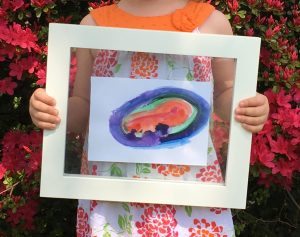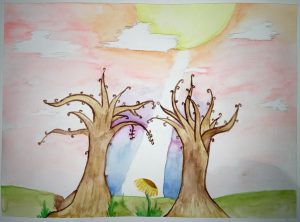By Clara Keane | August 10, 2017 | Health Care
Thank you to everyone who has shared their meaningful stories with us. The AATA continues to gather stories and vignettes from art therapists to help answer the familiar question, “What is Art Therapy?” In a previous article, two art therapists wrote about clients who battled daily anxiety: one had experienced trauma, and the other suffered from a chronic disease. The following three stories describe powerful moments when art therapists assisted clients who struggled with memory deficits and helped them express their feelings and communicate through art. If you have not yet had the opportunity to participate, we invite you to share your story, through our Voices of Art Therapy page, which may be found online. Please include accompanying artwork with your story. The following stories were contributed by our members.
 “Beth’s Gift to Her Family” by Laurie Dombroff, BFA, MA, LGPAT
“Beth’s Gift to Her Family” by Laurie Dombroff, BFA, MA, LGPAT
I work with adults, many who have dementia, at the Easter Seals of Greater Washington, Adult Day Center in Silver Spring, Maryland. Several years ago, I met Beth, who was in the late stages of dementia. The disease had progressed and when I met her she was no longer verbal. So together, Beth and I began to explore different art materials. Most did not seem to engage her. She had no language and little to no affect. I relied on any subtle changes in her face or body movement to find an art material she would be receptive to.
One day, I offered her a Buddha board and placed the wet brush in her hand. I guided her hand to the board and she began to make marks on her own. I was hopeful that I had found her medium. The next week, I tried watercolor. We put the brush in her hand and she began to move the brush around. We changed the color and she continued surrounding the shape until it was enclosed. The staff and I were unsure of the meaning of the image, but we were delighted that in that moment she was able to make such a deliberate image.
Beth died a short time later. Her family came to the center to thank the staff shortly thereafter. On that visit the staff showed them the painting and they understood it’s meaning immediately. Beth had been a labor and delivery nurse, and her daughter was expecting a baby in the coming months. Beth had found a way to tell them she knew. Hannah was born on Beth’s birthday. This story is a constant reminder to me about how important this work is. I hold on to the idea that even when it seems as if a participant can no longer express themselves, through guided art making it is still be possible.
“Fading Colors” by Sheryl Stern, MA, ATR-BC, LCAT, LMFT
He chose orange from the paint tray! Smiling, his brush heavy with color sweeps across the page. What follows is blue. At times the colors intersect, and he is pleased. I know this much because he’s laughing. What I don’t know, is what brings about his joy. He identifies another color. And with equal enthusiasm, he covers the paper. He sits back and observes his art. “Are you done”, I ask. A smile is followed by a simple “yes”. The art is set aside and saved.
The paint tin, paper and brushes sit in front of him. He doesn’t know what to do. I ask if he’d like to paint? I ask about color choices, which have been narrowed to just a few? Using hand over hand we create little by way of color, movement or enjoyment. The art is set aside and saved.
No paint, no smiles, few words are exchanged upon my next visit. I set up his passed brightly colored art pieces, next to the fading works which followed. All were set aside and saved. He appears as if he recalls the joy they brought. However…I don’t know. What I’m seeing is the blank stare of Alzheimer’s Disease. And this is my brother.
 “Inside/Outside” by Tracy Councill, ATR-BC, LCPAT
“Inside/Outside” by Tracy Councill, ATR-BC, LCPAT
A young woman who had been fighting a rare solid tumor diagnosis experienced an intense onset of symptoms that left her with big holes in her memory. When she got out of the hospital, she used art therapy as an outpatient to both process her feelings and retrain her memory.
One day in particular she reflected on times when she felt she had to show the world a different state than what she was actually feeling inside. Friends might ask, “you look great–are you better?,” but an authentic response was complicated.
In art therapy she created this watercolor to explore her conflicting “inside” and “outside” states and see what clarification might come from putting it in image form. For two hours she painted and talked with her art therapist about how she “really” felt versus how people thought she “should” feel.
When the painting was finished, she explained that the process had helped her understand that what she needed most from people was time. She closed the session by saying, “Thank you for being here. Where else do you get to really talk about what’s happening and then spend a whole morning making it into a painting that totally means what you were trying to say?”
Stories are presented as they were submitted by the authors and have not been modified by the AATA.
How to Share Your Story
There are many ways to describe art therapy and often a story is a powerful way to share our work. We know these amazing stories because we experience them every day and have the honor of witnessing the impact of art therapy in people’s lives. Now it’s time to share those stories with the world.
Here are some tips for effective storytelling:
- Provide focus: Concentrate on one succinct story to allow readers to connect with the experience.
- Be visual: Compelling images draw readers in. Select artwork that sparks emotion and grabs your attention.
- Use real details: Quotes, sights, sounds, and events help make your story more tangible and relatable.
- Get personal: Focus your attention on the central figure of your story. Tap into human emotion, enabling readers to form a connection with him/her/them.
Please share this link with your colleagues; all art therapists are encouraged to participate!
